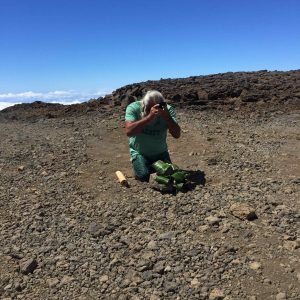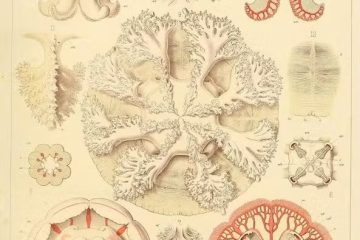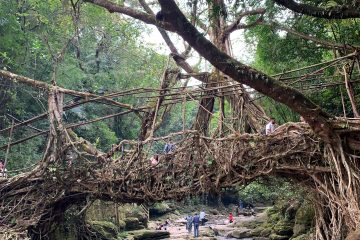Telescopes, Blind Spots, and Future Horizons on Mauna Kea
By Greg Johnson

This post pertains to the TMT project on Mauna Kea (Hawai`i), which the author has written about on this forum previously. For important background and analysis of the dispute, see this forum in Radical History Review.
On 4 November 2021, the U.S. National Academies of Science released its decadal survey, revealing priorities for supporting major astronomy projects in the near- and mid-term future. The Thirty Meter Telescope project (widely known as TMT) is in a class awarded a “highest priority” status, giving the project renewed life, at least in terms of government support and the possibility of a much-needed financial boost from the National Science Foundation (NSF). However, U.S. federal funding, something the TMT has not had up to now (perhaps for strategic reasons), comes with more stringent environmental and cultural impact assessment mechanisms than the project has been subjected to thus far. Now the State of Hawai`i and the TMT corporation must engage in what promises to be a long, cumbersome review process.
Simultaneously and tactically, these entities will wage a narrative campaign, once again telling a two-fold story. Themes focusing on scientific progress, benefits for all of humanity, and economic incentives will characterize the primary thrust of the message, a narrative saturated with a peculiarly American form of techno-optimism, to invoke Lisa Sideris’ apt term. Recent history suggests that another chirping echo will be prominent as well: an account acknowledging that Native Hawaiian resistance is possible, with an assurance that it will come only from a minority faction of radical activists. Counterfactual tropes will be resuscitated in the service of this telling. The protestors, who prefer the term kia`i (protectors), will be dismissed as “fundamentalists” who are anti-science, whose cultural sensibilities are frozen in time, whose claims to the sacred status of the mauna are invented and political, and who are alarmingly bereft of accountability to law and potentially prone to violence. To support this framing, state and TMT representatives can be expected to revisit the ruling of the State Supreme Court in 2018 that affirmed TMT’s construction permit, relying on findings from the contested case of 2016–2017. Recycling of this sort will add insult to injury. Native Hawaiian petitioners and intervenors participated in the contested case process with tremendous energy and commitment, only to see their evidence denied and their stories fall on mute ears.
My aim here is to amplify a different and empirically grounded storyline. I say amplify because it is an account being told by many Native Hawaiians from numerous walks of life, including a number of scholars from a diversity of fields. For example, I strongly encourage readers to engage the work of Noelani Goodyear-Ka`ōpua, Marie Alohalani Brown, and David Uahikea Maile, among numerous others. Those who take my suggestion will find rich analyses of the movement to protect Mauna Kea.
Among other notable facets such as legal challenge, the movement has entailed two well-documented direct action protest encampments, one in the summer of 2015 and one that began on 15 July 2019 and lasted well into 2020. Reviewing academic, artistic, and social media representations of the camps reveals a narrative quite different than that espoused by supporters of TMT. Here we find cultural vitality in a range of registers. Far from fomenting destruction, the camps were governed by an ethos and ethic of non-violence. Comportment in the camps and on the protest lines was guided by kapu aloha, a shared commitment to peaceful action that draws upon layers of traditional practice as well as the legacies of Gandhi and Martin Luther King, Jr., among others. This articulation of tradition as a deliberate mode of collective self-care in the face of potential state-sanctioned violence has been culturally formative. Hawaiian culture lived and changed in the camps. Neither frozen nor violent, it was expressed in thrice daily ceremonies that centered on ancient and contemporary forms of chanting, prayer, hula, and gift-giving. It boomed down the mountain during community celebrations of song and music. It was nurtured through ample and free food, on-site health care, assistance with lodging, waste management (not to be casually dismissed!), and a vibrant grass-roots school, Pu`uhuluhulu University, which among other curricula taught science classes.
As a scholar of religion, I find the movement fascinating and instructive, as a human I have been compelled by my experiences in the camps, and as a citizen I am concerned with legal protections of Indigenous places and the communities who stand for them. The latter point is crucial here. Article 12.7 of the Hawai`i State Constitution holds out the promise of protection for Native Hawaiian traditions and places they depend upon. In practice, however, the state has failed to see and hear Hawaiians and the stories that give cultural texture and traditional meaning to their contemporary actions. They have been dismissed by law and its agents, not to mention mainstream media. The movement was never about being anti-science and anti-modern. It is about being recognized and respected as a vibrant if not homogenous Native community in the contemporary moment—a community with self-respect, legal rights, and a deep knowledge of history and its displacements. Their refusal was announced from this high ground, not from an imagined backwater bunker fortified against “progress.”
Where is hope to be found for a more rigorous and ethical accounting of Hawaiian tradition in the present? Land Back. That is the ideal on tip of many Indigenous tongues these days, including in Hawai`i, for all kinds of justifiable reasons. Restored sovereignty, or at least Native Hawaiian control over public lands including Mauna Kea, would be a just future. This remedy may well be on the horizon. But the specter of construction on the mountain looms close. Short of asserting their own jurisdiction and risking incarceration, penalties, and possible harm, what relief might the kia`i find in the legal and administrative sphere while they hold space on the ground?
In an irony of history, temporary relief might be found in the laws of the colonizer and in the findings of classic agents of empire, anthropologists. Subsequent to the decadal survey, if the NSF awards TMT funding, federal consultative review processes will be triggered pursuant to the National Environmental Policy Act and section 106 of the National Historic Preservation Act, which, as Michael McNally reminds us, has been amended in recent years in ways that enfranchise Native culture claims, including those of Native Hawaiian Organizations. Unlike state review, which relied upon archaeological experts and other non-contemporary and non-Indigenous ways of reckoning the pulse of Hawaiian tradition, 106 consultations are in part guided by cultural anthropologists trained to hear and see living tradition. At a minimum, their methods demand time, which is already a win for the kia`i. Most importantly, while doing their work, consulting anthropologists might well be persuaded that culture is unfolding and unfurling in real time on Mauna Kea. Were that to be the case, federal 106 consultations and the reports that come out of them could tell this important story and in doing so open the door to possible protection of a sacred place. Beyond setting a new course for the TMT dispute, sincere participation in the 106 consultation process by all parties could serve as an exemplar for future scientific projects that seek Indigenous engagement.
But consultation is far short of consent. Native Hawaiians know this well, so I strongly suspect they aren’t investing too much in this prospect, especially since they have so little to bank on in terms of evidence about the good faith intentions of other parties at the table. Meanwhile, the very minimum amendment I would offer to the dominant narrative is this: if TMT goes forward, protracted resistance on the ground is not a possibility, it is a certainty. Scientific studies tell us this much.
#
Greg Johnson is Professor of Religious Studies and Director of the Walter H. Capps Center for the Study of Ethics, Religion, and Public Life at the University of California, Santa Barbara, an institution directly implicated in the Mauna Kea dispute. He visited the encampments on Mauna Kea several times in 2015 and 2019 and was a witness for intervenor William Freitas in the contested case (2016–2017).
Counterpoint blogs may be reprinted with the following acknowledgement: “This article was published by Counterpoint Navigating Knowledge on 16 November 2021.”
The views and opinions expressed on this website, in its publications, and in comments made in response to the site and publications are those of the author(s) and do not necessarily reflect the views and opinions of Counterpoint: Navigating Knowledge, its founders, its staff, or any agent or institution affiliated with it, nor those of the institution(s) with which the author is affiliated. Counterpoint exists to promote vigorous debate within and across knowledge systems and therefore publishes a wide variety of views and opinions in the interests of open conversation and dialogue.
Photo credits: “William Freitas making an offering at the proposed TMT site near the summit of Mauna Kea,” © Greg Johnson, 2021.



